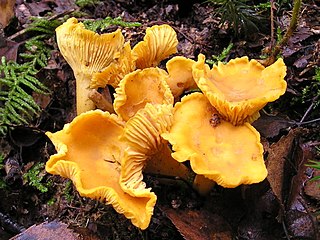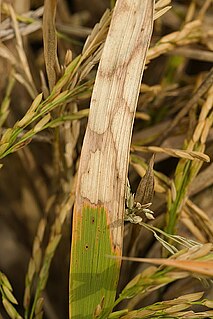
Biotechnology is a broad area of biology, involving the use of living systems and organisms to develop or make products. Depending on the tools and applications, it often overlaps with related scientific fields. In the late 20th and early 21st centuries, biotechnology has expanded to include new and diverse sciences, such as genomics, recombinant gene techniques, applied immunology, and development of pharmaceutical therapies and diagnostic tests. The term biotechnology was first used by Karl Ereky in 1919, meaning the production of products from raw materials with the aid of living organisms.

Brassica is a genus of plants in the cabbage and mustard family (Brassicaceae). The members of the genus are informally known as cruciferous vegetables, cabbages, or mustard plants. Crops from this genus are sometimes called cole crops—derived from the Latin caulis, denoting the stem or stalk of a plant.

The Cantharellales are an order of fungi in the class Agaricomycetes. The order includes not only the chanterelles (Cantharellaceae), but also some of the tooth fungi (Hydnaceae), clavarioid fungi, and corticioid fungi (Botryobasidiaceae). Species within the order are variously ectomycorrhizal, saprotrophic, associated with orchids, or facultative plant pathogens. Those of economic importance include edible and commercially collected Cantharellus, Craterellus, and Hydnum species as well as crop pathogens in the genera Ceratobasidium and Thanatephorus (Rhizoctonia).

Iprodione is a hydantoin fungicide and nematicide.

Plant Genetic Systems (PGS), since 2002 part of Bayer CropScience, is a biotech company located in Ghent, Belgium. The focus of its activities is the genetic engineering of plants. The company is best known for its work in the development of insect-resistant transgenic plants.

Rhizoctonia solani is a plant pathogenic fungus with a wide host range and worldwide distribution. It was discovered more than 100 years ago. R. solani frequently exists as thread-like growth on plants or in culture, and is considered a soil-borne pathogen. R. solani is best known to cause various plant diseases such as collar rot, root rot, damping off, and wire stem. R. solani attacks its hosts when they are in their early stages of development, such as seeds and seedlings, which are typically found in the soil. The pathogen is known to cause serious plant losses by attacking primarily the roots and lower stems of plants. Although it has a wide range of hosts, its main targets are herbaceous plants. R. solani is a basidiomycete fungus but the teleomorph stage is not prominent. Occasionally, sexual spores (basidiospores) are produced on infected plants. The disease cycle of R. solani is important in management and control of the pathogen. The pathogen is not currently known to produce any asexual spores (conidia), though it is considered to have an asexual lifecycle perpetuated through sclerotia.

Damping off is a horticultural disease or condition, caused by several different pathogens that kill or weaken seeds or seedlings before or after they germinate. It is most prevalent in wet and cool conditions.

Ceratobasidium cornigerum is a species of fungus in the order Cantharellales. Basidiocarps are thin, spread on the substrate out like a film (effused) and web-like. A Rhizoctonia-like anamorphic state, sometimes referred to the genus Ceratorhiza, is frequently obtained when isolates are cultured. Ceratobasidium cornigerum is saprotrophic, but is also a facultative plant pathogen, causing a number of economically important crop diseases, and an orchid endomycorrhizal associate. The species is genetically diverse and is sometimes treated as a complex of closely related taxa.
Waitea circinata is a species of fungus in the family Corticiaceae. Basidiocarps are thin, effused, and web-like, but the fungus is more frequently encountered in its similar but sterile anamorphic state, sometimes called Rhizoctonia zeae. Waitea circinata is best known as a plant pathogen, causing commercially significant damage to cereal crops and turf grass.

Heterodera avenae, the cereal cyst nematode or European cyst nematode, is a plant pathogen and an obligate parasite of cereal crops including barley, oats, wheat and rye. Cereal crops infected with this nematode are more susceptible to infection by fungal diseases such as rhizoctonia root rot.

Bayer AG is a German multinational pharmaceutical and life sciences company and one of the largest pharmaceutical companies in the world. Headquartered in Leverkusen, Bayer's areas of business include human and veterinary pharmaceuticals; consumer healthcare products; agricultural chemicals, seeds and biotechnology products. The company is a component of the Euro Stoxx 50 stock market index. Werner Baumann has been CEO since 2016.

Genetically modified rice are rice strains that have been genetically modified. Rice plants have been modified to increase micronutrients such as vitamin A, accelerate photosynthesis, tolerate herbicides, resist pests, increase grain size, generate nutrients, flavours or produce human proteins.

Ceratobasidium is a genus of fungi in the order Cantharellales. Basidiocarps are effused and the genus is sometimes grouped among the corticioid fungi, though species also retain features of the heterobasidiomycetes. Rhizoctonia-like anamorphs of Ceratobasidium species are placed in the genus Ceratorhiza. Species are saprotrophic, but several are also facultative plant pathogens, causing a number of commercially important crop diseases. Some are also endomycorrhizal associates of orchids.

Rhizoctonia is a genus of anamorphic fungi in the order Cantharellales. Species do not produce spores, but are composed of hyphae and sclerotia and are asexual states of fungi in the genus Thanatephorus. Rhizoctonia species are saprotrophic, but are also facultative plant pathogens, causing commercially important crop diseases. They are also endomycorrhizal associates of orchids. The genus name was formerly used to accommodate many superficially similar, but unrelated fungi.

The Ceratobasidiaceae are a family of fungi in the order Cantharellales. All species within the family have basidiocarps that are thin and effused. They have sometimes been included within the corticioid fungi or alternatively within the "heterobasidiomycetes". Species are saprotrophic, but some are also facultative plant pathogens or are associated with orchid mycorrhiza. Genera of economic importance include Ceratobasidium and Thanatephorus, both of which contain plant pathogenic species causing diseases of commercial crops and turf grass.

Thiacloprid is an insecticide of the neonicotinoid class. Its mechanism of action is similar to other neonicotinoids and involves disruption of the insect's nervous system by stimulating nicotinic acetylcholine receptors. Thiacloprid was developed by Bayer CropScience for use on agricultural crops to control of a variety of sucking and chewing insects, primarily aphids and whiteflies.
4-Hydroxyphenylpyruvate dioxygenase (HPPD) inhibitors are a class of herbicides that prevent growth in plants by blocking 4-Hydroxyphenylpyruvate dioxygenase, an enzyme in plants that breaks down the amino acid tyrosine into molecules that are then used by plants to create other molecules that plants need. This process of breakdown, or catabolism, and making new molecules from the results, or biosynthesis, is something all living things do. HPPD inhibitors were first brought to market in 1980, although their mechanism of action was not understood until the late 1990s. They were originally used primarily in Japan in rice production, but since the late 1990s have been used in Europe and North America for corn, soybeans, and cereals, and since the 2000s have become more important as weeds have become resistant to glyphosate and other herbicides. Genetically modified crops are under development that include resistance to HPPD inhibitors. There is a pharmaceutical drug on the market, nitisinone, that was originally under development as an herbicide as a member of this class, and is used to treat an orphan disease, type I tyrosinemia.
Stem rot is a disease caused by a fungus infection in the stem. Fungus that causes stem rot are in the Rhizoctonia, Fusarium or Pythium genera. Stem rot can readily infect crops that are in their vegetative or flowering stages. The disease can survive up to five years in the soil. Symptoms of stem rot includes staining of infected area, reduced crop yield and crop failure. The disease can be spread through the use of unfiltered water as well as unsterilized tools. Also leaving previous dead roots in soil can increase the risk of stem rot. Spores can also enter the plant through injured stem tissue on the plant including from insect attacks. The fungus impedes stem functions like transporting nutrients. It can cause water to leak through the lesions of stem tissue. Common infected crop plants are soybeans and potatoes. An issue with maintaining this disease is the lack of management by crop producers. Producers of soybeans tend to not manage for the disease because it is not normally yield limiting in a large area. Fungicides can be used to manage the disease as well as burning the crop after harvest or letting it decompose.

Rice-sheath blight is a disease caused by Rhizoctonia solani, a basidiomycete, that causes major limitations on rice production in India and other countries of Asia. It is also a problem in the southern US, where rice is also produced. It can decrease yield up to 50%, and reduce its quality. It causes lesions on the rice plant, and can also cause pre- and post-emergence seedling blight, banded leaf blight, panicle infection and spotted seed.

Indaziflam is a preemergent herbicide especially for grass control in tree and bush crops.
















